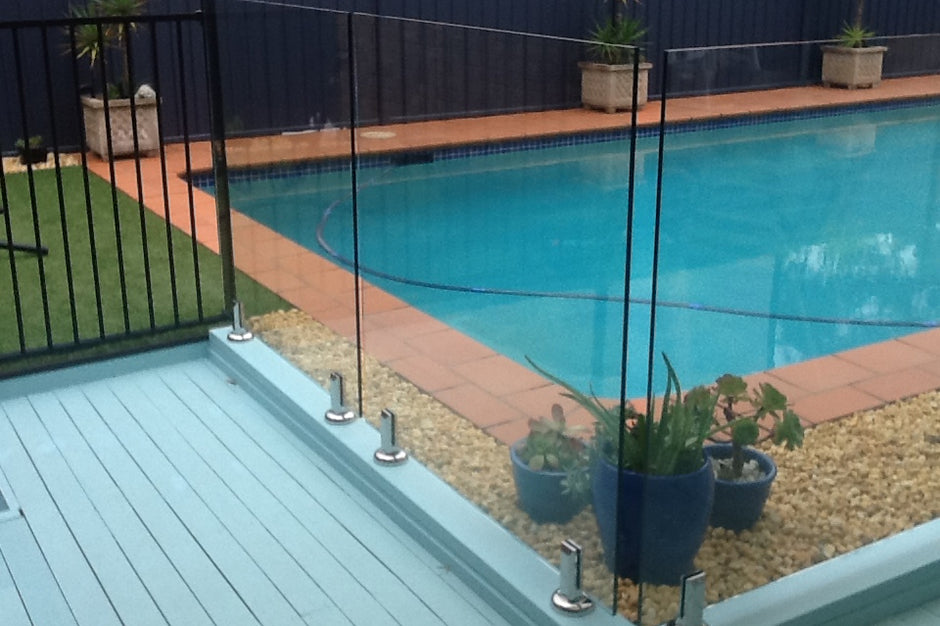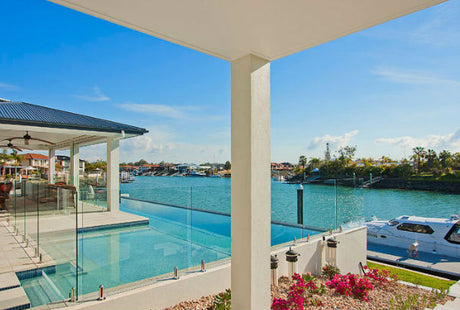Installing Base Mounted Spigots into Fibre-Cement: A Step-by-Step Guide
This installation guide will go over how to install a base mounted spigot into fibre cement. Need to purchase base mounted spigots? Head on over to our Spigots page to purchase one now!
Fibre-Cement Boards Explained: Benefits and Uses
‘Fibre Cement’ (FC), ‘Fibre Reinforced Cement’ (FRC) or ‘Compressed Fibre Cement’ (CRC) is an asbestos-free material usually encountered in the form of large sheets, boards or planks. FC is typically used as an exterior siding, interior walls and floors, and in thicker sheets as flooring for tiled decks.
When a new glass pool fence or balustrade is to be fixed to a new or existing FC substrate, all the standard structural regulations apply – just as they would for timber or on concrete. Often, at the edge of an FC deck there will be timber to fix – but, as in the example below, noggins should be fitted to allow the use of standard coach screws where there is nothing present.
Preparation Checklist: What You Need Before Installation
Your Site Will Require:
- A hard, level unloading surface suitable for a pallet jack
- Sufficient access / unloading area
- Flat storage area with a clean timber pallet (or similar) and clean timber rails for separation and protection
- Mains Electricity - 240V, 10AMP
Determining the Correct Spigot Spacing for Your Project
Follow the guide below to ensure your spigot positioning complies with TGD’s testing, AS1288 and glass panel span regulations.

| Glass panel width | Distance from panel end |
| 100-600mm* | *special installation required – please contact our office |
| 600-900mm | X = 125mm |
| 1000mm-1200mm | X = 150mm |
| 1300-1500mm | X = 200mm |
| 1500+* | X = 250mm / *special installation required – you may need 3 spigots - please contact our office |
How to Fix Round Spigots

With good quality tools, including an Allen key set, a drill and bits, sockets, spanners, fit your base-plated (‘flanged’) spigots onto your FC/tiled deck using a pilot drill and SS M10 x 75mm coach screws ORwith M10 stainless steel threaded rod, cut tono less than 90mm in length with nuts and washers both ends. Round spigots are secured with FOUR fixings –use either the in-line (L) or the diagonal (D) slots.

Spigots should be fitted so the final glass line is approx. 100mm from the edge of your deck or structure to prevent cracking or splitting of the timber base. The use of threaded rod will require full access beneath the noggin to tighten the nuts.
How to Fix Square Spigots

Using the same method, square spigots are secured by only FOUR fixing that are in-line as shown below with ‘L’. The heads of your coach screws will foul and damage the spigot if the slots are used.

The Role of Noggins in Spigot Installation
Noggin fitment will be required when spigots falls on a part of the deck which has no structural member to support the underside of it. Noggins are braces fitted between joists to provide a solid fixing point for the glass panel. Noggins should be a min. of 140mm x 40mm and attached with builder’s angle brackets and screw into the deck’s bearers.
TIP: many fixings and fittings can be sourced and supplied by Trade Glass Depot!
If your deck does require noggins, you’ll need to calculate exactly where the spigots will fall under the deck’s surface. At these points, timber noggins will need to be secured to give the spigots a solid structural foundation when screwed in.
There are many types of deck construction and timber qualities, but a typical noggin/s or ‘joist block’ will have a minimum specification of 140mm x 45mm “T3/H3 MGP10 Rougher Header treated pine” and supported by galvanised angle brackets and screws.
BEFORE: The raised deck shown here has no timber approx. 100mm in from the deck edges, where the spigots will fall.

AFTER: Noggins fitted at edge of Deck where the spigots will fall and secured by builders angle brackets.

Properly Marking Out Your Installation Area
- Chalk line the desired centre line for your glass panels (timber deck is shown below).
- Remove the black plastic insulator from the spigot to enable better alignment by eye to the chalk line guide.
- Check that the proposed spigot placement will coincide with the new noggins when fitted.
CAUTION!
Consult your hardware supplier and/or timber supplier to ascertain the correct pilot and clearance holes for your particular screws and noggins. Failure to do so could result in a loose fixation or cracked timber.
- An inserted straight edge held firmly may also assist in alignment.
- Mark through the correct holes in the spigots, placing the in-line holes along the chalk line.
- Mark fully on the chalk line where the spigot’s holes and glass panel gaps will fall.

NOTES:
- When setting out, ensure the closest proposed hole is at least 50mm from the edge of the flooring -any less would run the risk of splitting the timber under load -i.e. glass centre line runs 100mm from the edge of the deck
Tools Required:
- Chalk line, spirit level and tape measure
- Coring machine and mini-corer bit x 16mm dia.
- Mains pressure water, bucket and sponge
- Electric drill, 6mm standard drill bit, 13mm nut driver and 10mm masonry drill bit
- 13mm ring spanner and a 13mm nut driver and set of Allen keys
- silicone sealant, rubber mallet
Assembling and Fitting Your Spigots
- Clear the area
- Create a temporary core-drill guide from a piece or 12mm plywood or similar. This will serve as a ‘steady’ and prevent the mini-core drill bit ‘wandering off’ since it has no starting centre point
- Use a mini-core drilling machine and 16mm dia. bit, cut through the ceramic tiles at your 4 positions per mount using a gentle motion and light pressure

Using a standard drilling machine and recommended pilot drill, drill ALL of the holes to a depth of approx. 70mm. If the hole ‘breaks through’, then the spigot will have only FC to fix to and will require fitment of a noggin to take a standard M10 x 75 coach screw.

- Mark out the 4-hole positions on each of the rubber spigot insulators and drill through 10mm dia. on a piece of scrap timber

- Prepare each spigot with its plastic pressure plate insulator and the rubber base insulator. Keep in mind that the panel securing Allen head grubs screws on the spigot should all face away from the deck edge for ease of access
- Clean the mounting area with water to avoid slurry staining and apply a generous amount of sealant to the tiles and holes for waterproofing

- Insert the coach screws
- Using a 13mm nut driver, screw them in approx. 80% of their lengths and then slowly nip them all up, ensuring square and slot alignment to the centre chalk line as you go
- With a new Stanley knife blade or similar, cut around the base plate to remove the excess rubber
- Fit the dress rings
- Use the 'buddy system' to fit your glass panels and gate if required –DO NOT force panels into place, check and adjust the spigots as needed. Some adjustment with packers or shims may be necessary –refer to our ‘How to Pack and Shim' guide

- Fit the handrail as required by referring to TGD’s ‘Handrail Installation' guide
Still Facing Issues? Contact Our Experts for Help!
Still having trouble with your installation? Why not contact us today through our phone number 1300 889 375 and we can gladly solve any issues you have. We can swiftly solve any of your problems regarding pool fence installation. Need to purchase some base mounted spigots? Head on over to our Spigots page!



